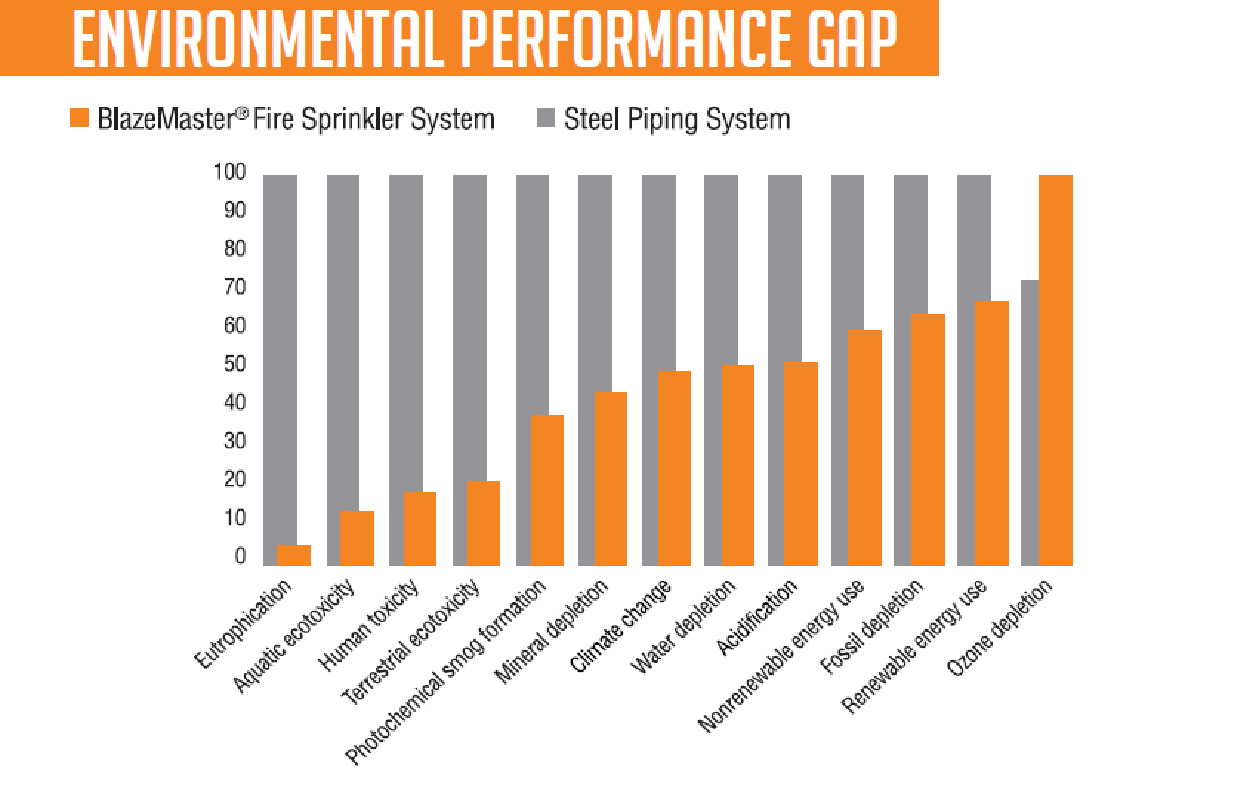
Fire Sprinkler Piping System by BlazeMaster® Compliments Green & Sustainable Building
CPVC Performance | on December 28th, 2020
Green building (also known as green construction or sustainable building) refers to both a structure and the application of processes that are environmentally responsible and resource-efficient throughout a building's life-cycle: from planning to design, construction, operation, maintenance, renovation, and demolition.
In the last decade, there has been a great interest in green, sustainable building and in India, many states are offering incentives to building owners to construct green, sustainable buildings.
India currently mostly uses Steel (Galvanized Iron & Mild Steel) pipe and fittings for Fire sprinkler piping systems. However with the making of IS: 16088 by BIS, India, there has seen great interest in moving from Steel Fire sprinkler piping systems to BlazeMaster® CPVC fire protection systems.
Besides various advantages of being lightweight, ease of installation, long life, and many others let's understand how BlazeMaster® CPVC fire protection system compliments green, sustainable buildings.
BlazeMaster® CPVC fire protection system vs. Steel Fire sprinkler piping systems – Sustainably Speaking
The most popular tool around the world to understand the environmental impact of a product is the life-cycle assessment, as it helps engineers to make an informed decision on the choice of material which can help improve the rating of green sustainable construction.
The Life-cycle assessment Study
Life-cycle assessment ( LCA, also known as life-cycle analysis, ecobalance, and cradle-to-grave analysis) is a technique to assess environmental impacts associated with all the stages of a product's life from raw material extraction through materials processing, manufacture, distribution, use, repair, and maintenance, and disposal or recycling. It goes beyond the carbon and global warming emphasis, including categories of environmental effects that cover the depletion of resources, acidification, and human toxicity. It tests 13 impacts on the climate.
Lubrizol Advanced Materials creators of BlazeMaster® CPVC fire protection system support green, sustainable building practices and to learn about the environmental impact of the product compared to metal sprinklers, conducted a Life Cycle Assessment (LCA).
The LCA was performed by Environmental Resources Management, an independent environmental research firm. It conducted an LCA of two common materials used for fire sprinkler systems in the U.S. — steel piping and BlazeMaster® CPVC fire protection systems — to determine which material's production, use, and end of life were more detrimental to the environment.
In the ISO-compliant study, BlazeMaster® CPVC fire protection system was compared against steel in 13 categories of environmental impacts. One might assume that the metal material – made of raw components from the earth – would be the more sustainable material of the two.
That assumption was proven wrong on 12 of 13 measurements. In the report, the following categories of environmental impact are included:
- Eutrophication - Excessive nutrients lead to abnormally high rates of microbial growth in aquatic environments (e.g. algae blooms). Fast microbial growth rates contribute to the depletion of oxygen, which can kill species within the ecosystem.
- Aquatic toxicity - Aquatic toxicity refers to the effects of a substance on water-based species and is normally determined for three-level organisms, i.e. vertebrates (fish), invertebrates (crustaceans), and plants (algae) (source: European Commission).
- Human toxicity - The human toxicity potential (HTP) is based on both the intrinsic toxicity of a substance and its potential dosage, a measured index that represents the potential harm of a unit of chemical released into the environment. It is used as a reference compound for the weighting of emissions inventoried as part of an LCA or in the Toxics Release Inventory (TRI) and to aggregate emissions. In terms of benzene equivalence (carcinogens) and toluene equivalents, overall emissions can be measured (non-carcinogens). (source: Environmental Toxicology and Chemistry).
- Terrestrial toxicity - Terrestrial toxicity is characterized as the study of the effects on terrestrial organisms and plants of a chemical substance. Assessment of their terrestrial toxicity is important for many agrochemicals to protect our environment.(source: Chem Safety Pro).
- Photochemical smog production - Smog is caused by the reaction of sunlight to air pollutants such as volatile organic compounds (VOCs), nitrogen oxides (NOx) and carbon monoxide (CO), which have a negative effect on human health and are toxic to plants.
- Mineral depletion - In the form of minerals, the loss of non-renewable natural resources (often used for making metals).
- Climate change - Man-made greenhouse gas emissions allow heat to be concentrated in the atmosphere, resulting in harmful effects on the environment.
- Depletion of water - Usage of fresh water at a rate faster than can be replenished(source: USGS).
- Acidification - Emissions of sulfur dioxide, ammonia, and NOx can contribute to acid rain, which can limit freshwater, ocean, and surface pH.
- Energy consumption - Various forms of energy that influence global warming and resource depletion are consumed during the life cycle of a product.
- Depletion of resources - Exploitation of resources, such as iron ore, crude oil, coal and other non-living resources, restricts future generations' choices and can potentially lead to more dangerous methods of mining and exploration.
- Depletion of the ozone layer - Compounds that deplete ozone, such as chlorine from chlorofluorocarbons (CFCs), decrease the capacity for absorption of ultraviolet radiation in the stratosphere.
BlazeMaster® CPVC fire protection system beat steel in 12 of the 13 categories. This makes BlazeMaster® CPVC piping a preferred material over steel for environmentally conscientious builders as it compliments their efforts in constructing green sustainable buildings.

Other Benefits of BlazeMaster® CPVC fire protection system over steel
BlazeMaster® CPVC fire protection system can actually help buildings earn a LEED® certification. LEED® certification is an internationally recognized mark of accomplishment and leadership in sustainability. LEED is for all forms of construction and all stages of construction, including new houses, interior fit-outs, operations and repairs, and core and shell.
During installation, BlazeMaster® CPVC fire protection system provides more advantages and savings, helping to save power/electricity the metal pipes use to cut, weld and transport the material.
BlazeMaster® CPVC fire protection system does not use any power or any specialized equipment. For the joining of pipes and fittings, it only utilizes a cutter, chamfering tool and a CPVC red cold applied solvent cement.
In addition, the BlazeMaster® CPVC fire protection system is comparatively much lighter than steel, enabling fast and simple movement of materials, saving the use of motorized material movement equipment once again.
BlazeMaster® CPVC fire protection systems, with global as well as national focus on sustainability, offer this intangible advantage to its users and compliments the movement of green, sustainable buildings. The need for repair or replacement of a BlazeMaster® CPVC fire protection device is minimal with zero microbial mediated corrosion (MIC) and CPVC's inert nature.
CPVC is Recyclable
Although it is believed that steel can still be recycled, the recycling rate has also risen as the CPVC recycling system expands.
CPVC can currently be recycled as piping or window profiles for PVC. A specialist recycling firm (country-specific) can collect piping material on the job site and ground it into pellets and granules, which can be mixed into various applications, such as:
- Fillings of floor
- Coatings on the floor
- Trays with cable
- Bumps of pace
- Mats for Car
As the recycling system of CPVC expands and the recycling rate increases, the environmental performance gap of CPVC over steel can be expected to expand.
Conclusion
Combined with the corrosion resistance, rapid and simple installation process and lower costs of BlazeMaster® CPVC fire protection systems, the LCA findings are what make BlazeMaster® CPVC fire protection systems a more efficient and environmentally friendly option than steel. It thus contributes to the overall building's sustainability, and provides a significant incentive for its users to put themselves at the top of the green building hierarchy.
Please contact us if you have any questions about BlazeMaster® CPVC fire protection systems and green building design. We will appreciate the chance to explore how we can help.




